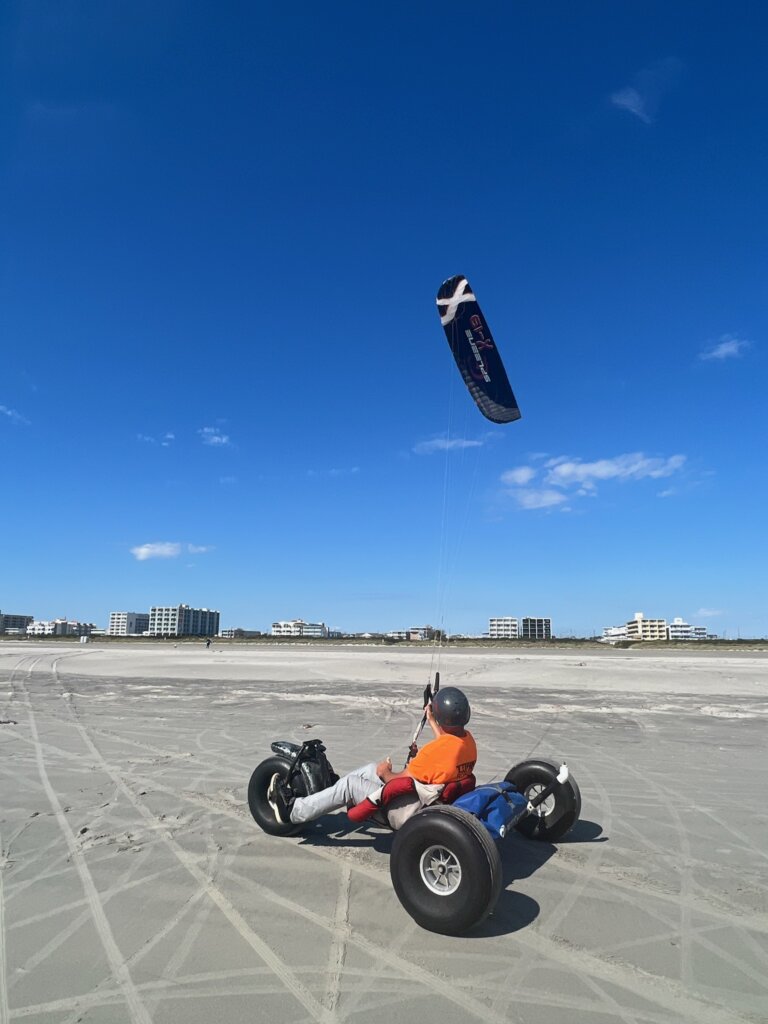Visitors to the Wildwood beaches in April and October might see three-wheeled buggies pulled by colorful kites running up and down the sand, as members of Wildwood Buggy Bash converge to have fun, socialize and enjoy the power of the wind.
Howard Abbey, of Toronto, said the group has been coming together twice a year for about 30 years. He’s been involved a little more than 12 years.
While the sport of kite buggying may seem easy, it’s really a skill that gets honed every ride, Abbey said.
“It’s similar to sailing, and we use the same terms,” he said. “The first thing you have to learn is how to fly a four-line kite. Once you learn how to work the sail, then you learn how to take advantage of the wind for motion.”

The group includes people from all walks of life, all ages, all ethnicities, and comes from all over the continent, but mostly from the northeast U.S. and Canada. Abbey, 63, is a condominium manager and helps obtain the group’s permits and insurance while arranging accommodations that often kick off and close the resort’s season.
“We have truck drivers, accountants, welders, all walks of life,” he said. “My wife has learned to fly the kite, but won’t do the buggy, for example. No license is required, but practically, you’ve got to be able to fly the kite and be competent driving it at the same time.”
The buggy has no brakes. Some models have a control with a bar for steering, while others use a handle. The kite is attached to a harness worn by the driver. Helmets are mandatory.
The sport, which Abbey said could be considered “extreme, but then so is skiing, or biking,” is one where the participant must pay attention to be safe, he said. You start by standing on the ground and learning to fly the kite. Then you learn to control the kite, and eventually muscle memory will kick in. Then you progress to sit in the buggy to work with the wind direction and with the motion of the vehicle.
Abbey recalled visiting a store in Las Vegas to buy a buggy early on in his hobby, and the store owner told him to come back when he could fly the kite.
“I understood what he was saying and respected him for that,” he said. “Even with thousands of hours of flying, you have to be careful because you can get hurt. My mom always said you needed to fall off a bike 10 or 100 times before you learned to ride it. This is the same thing; everyone is different in their abilities and how quickly they learn the skills.”

As in sailing, Abbey said, you learn to use a smaller kite when the wind is strong, a larger kite when the wind is weaker. This past October, about a dozen buggies could be seen on the Wildwood beaches during the week of Oct. 9, one of the smallest groups since they began coming to Wildwood. Some years, 70 buggies could be seen on the beaches, although 30 is more typical, he said.
On a “low-wind day, you can travel five to eight miles per hour,” he said. “You can basically double the wind speed for how fast you ride. Going out can be easy, but then you have to come back against the wind.”
Abbey said he enjoys moving at about 25 miles per hour, but is “confident” to about 40 miles per hour. As a “light guy with a small buggy,” he enjoys going up and down the hard-packed sand because “it’s fun. Why do you go for a bike ride?” he asked. “Because it’s fun. So is this.”
The group’s members do not compete against each other, Abbey said, but may compete with themselves.
He’s been hurt a few times over the years, cautioning that “you have to respect the power in the wind. If you respect it, are careful, it’s a lot of fun.”
Contact the author, Karen Knight, at kknight@cmcherald.com.







